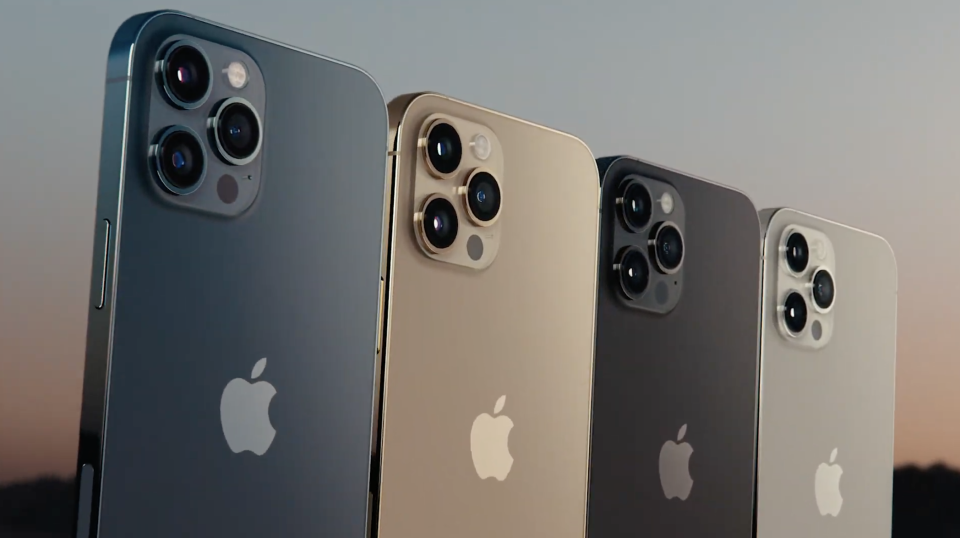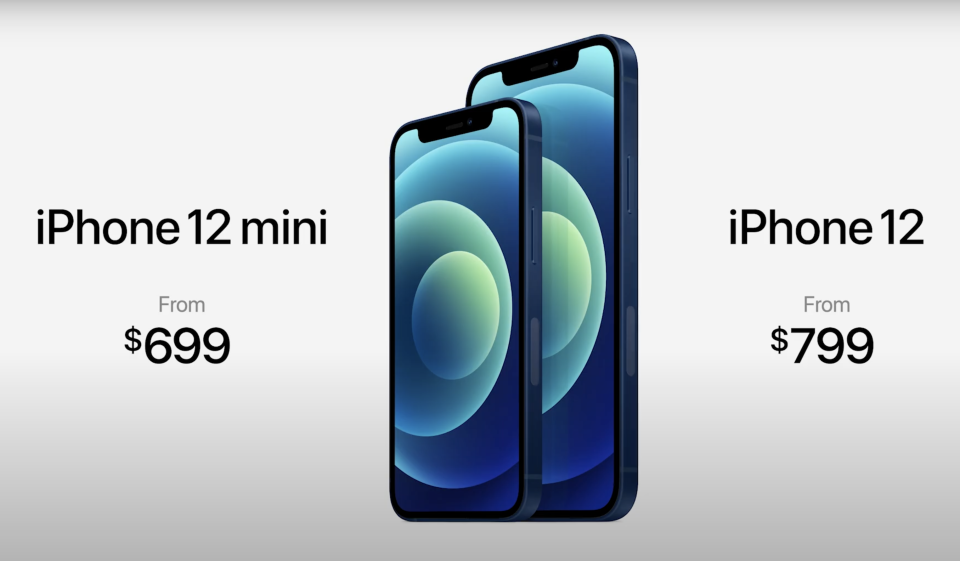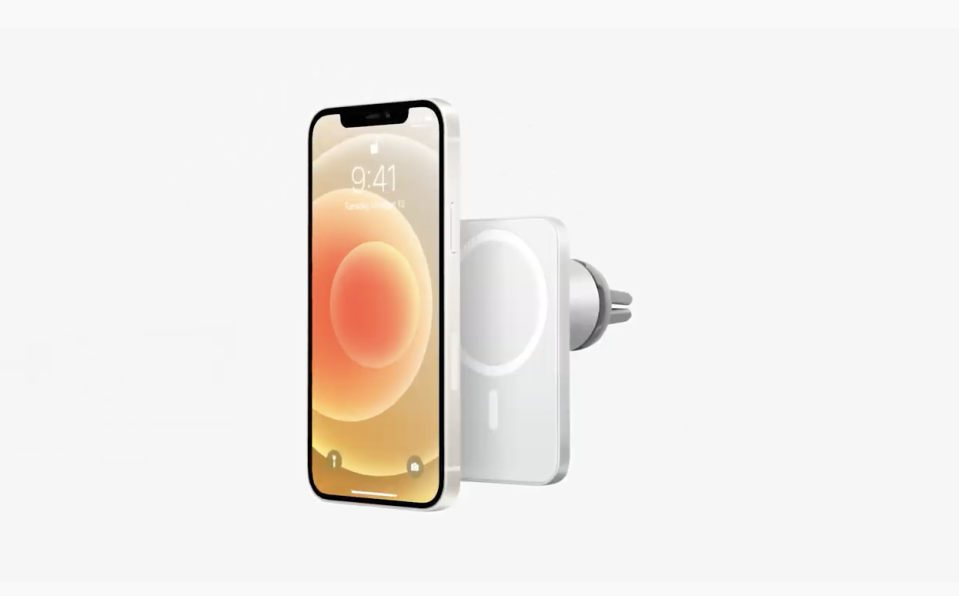Apple Event 2020: Apple unveils iPhone 12 & iPhone 12 Pro
Apple (AAPL) has officially debuted its first 5G iPhones with its new iPhone 12 mini, iPhone 12, iPhone 12 Pro, and iPhone 12 Max. Yes, that’s four new iPhones coming out of Apple this year, and all of them get the latest in high-speed cellular connectivity.
Analysts including Wedbush’s Dan Ives are predicting the new iPhones will kick off a sales “super cycle” in which Apple will see a major uptick in iPhones purchased by customers looking to upgrade to the first iPhones with 5G capabilities.
The phones range from $699 to over $1,000. Some of the biggest improvements include the largest display ever for an iPhone, dramatically improved cameras, and new wireless charging capabilities. The company also announced its new HomePod mini speaker and that it will no longer include headphones or charging bricks in its iPhones.
Prices and sizes
The entry-level iPhone 12, the mini, sports a 5.4-inch display, hence its “mini” moniker, and starts at $699. The mini is designed to appeal to users who are interested in a smaller, more pocket-friendly iPhone than the larger phones the company has been releasing in recent years.

The iPhone 12, meanwhile, gets a 6.1-inch panel and starts at $799. This iPhone is meant for consumers who want strong performance and a big screen, but don’t want to have to shell out as much as they would for the Pro models.
Speaking of which, the iPhone 12 Pro and its 6.1-inch screen start at $999, while the top-of-the-line iPhone 12 Pro Max and its 6.7-inch display, the largest yet, start at $1,099.
5G and what to expect
The standout feature of these new iPhones is the inclusion of 5G cellular technology. 5G provides faster upload and download speeds, as well as increased bandwidth over current 4G LTE connections.
Device makers such as Samsung have been offering 5G-enabled phones for a year already, so Apple isn’t exactly the first to market with the technology. But the fact that it is baking it into each of its new iPhones means the 5G adoption is bound to shoot up quickly.
Apple says it has included the most 5G bands in any other smartphone, meaning it will work on more 5G networks than other phones.

A new smart data mode will drop down from 5G to 4G LTE to help save on battery life when 5G connections aren’t needed. This would help offset the kind of energy issues other smartphones have experienced while using 5G.
Apple says it has seen speeds as high as 4 gigabits per second in ideal usage scenarios while on 5G when using millimeter wave networks. That’s far faster than the roughly 60 megabits per second you’d find on an LTE device.
Users, however, shouldn’t expect life-changing improvements overnight. While 5G is certainly faster than 4G LTE, it’s not as ubiquitous as the current standard.
What’s more, for consumers who can already stream and download videos and music and load websites in seconds over 4G LTE, 5G won’t seem like the massive change it is out of the gate. App developers and tech giants have yet to fully take advantage of the increased capabilities of 5G. That’s not to say they won’t, though.
It took a while for 4G LTE to spawn companies like Spotify (SPOT) and Uber (UBER), and you can expect similarly impressive new use cases and firms to sprout up around 5G. We’re just not quite there yet.
New look and more power
Each version of the iPhone 12 gets an overhauled look, as well. Rather than the rounded design Apple has used since the iPhone X launched in 2017, the company has opted for an angular style similar to the iPhone 5. The firm already gave us a small hint as to the new phones’ design when it introduced the iPad Air in September.
Apple has also outfitted each of the phones with its XDR Super Retina OLED, or organic light emitting diode, displays rather than simply putting those panels on the Pro models. OLED screens produce more vibrant colors and deeper blacks to create a better overall viewing experience compared to the LCD panel Apple used in the iPhone 11.
Apple says the new iPhones also get Ceramic Shield, a high-temperature crystallization that grows nano-ceramic crystals into the glass to make sure the display is more durable than any smartphone glass. Apple says it gets 4x better drop performance out of the glass than prior models.
Inside, the iPhones also get new wireless charging capabilities called MagSafe. Rather than dropping your phone on a charger, where it can often miss the charging sweet spot, the new charger will magnetically connect to the back of your phone, ensuring it’s charging properly.

As far as performance, all of the new iPhones get Apple’s new 6-core A14 Bionic processor. Apple originally debuted the chip in the iPad Air last month, saying that it is the company’s first to use a 5 nanometer process and includes a 4-core graphics architecture.
Cameras and LiDAR sensor
All of the iPhones also get new camera sensors starting with the iPhone 12 mini and iPhone 12, which sport both wide-angle and ultra-wide angle lenses. The wide angle lens now has a 7 aperture lens which Apple says offers a 27% improvement in low-light photos. The company says the phones’ machine learning capabilities, which power its computational photography, will dramatically improve image quality.
Night Mode will appear on all versions of the iPhone 12, rather than only on the Pro models like it did on the iPhone 11.
The iPhone 12 Pro and iPhone 12 Pro Max also get wide-angle and ultra-wide angle lenses, as well as telephoto lenses with up to 2.5x optical zoom. The iPhone 11 Pro and Pro Max also included telephoto lenses, though they only had 2x optical zoom capabilities.
Optical zoom provides far greater clarity than digital zoom, because it relies on the actual camera lens rather than software to push in on a subject. That alone is sure to get camera fans to opt for the iPhone 12 Pro and 12 Pro Max. What’s more, Apple says the 12 Pro gets an 87% improvement to low-light image quality.
The iPhone 12 Pro and Pro Max also get a built-in LiDAR, or light detection and ranging, sensor, which measures how long it takes light to reach and object and bounce back to provide a clearer depth map of a scene.
This enables precise placement of augmented reality objects in apps, and should also help with photography, improving autofocus time in both photos and videos. Apple says focus time in low-light scenes will be 6x faster, and improve Night Mode Portrait shots.
No more free power bricks or earbuds
One of the biggest changes to these new iPhones is Apple’s decision to not include power bricks or earbuds in their boxes. For years Apple has given consumers a complementary pair of earbuds and a power brick and cable with each new iPhone, but with the new iPhone 12 line, the company is doing away with the practice.
Part of the reasoning, Apple says, is to cut down on waste from its products. It makes sense, too, considering that you’ve likely already got plenty of chargers and cables floating around your home at this very moment.
But it could also prove to be an effective cost-saving measure for the company, and help steer consumers toward purchasing a pair of AirPods.
Got a tip? Email Daniel Howley at dhowley@yahoofinance.com over via encrypted mail at danielphowley@protonmail.com, and follow him on Twitter at @DanielHowley.
Read more Tech Support stories here.
More from Dan:
Follow Yahoo Finance on Twitter, Facebook, Instagram, Flipboard, SmartNews, LinkedIn, YouTube, and reddit.

